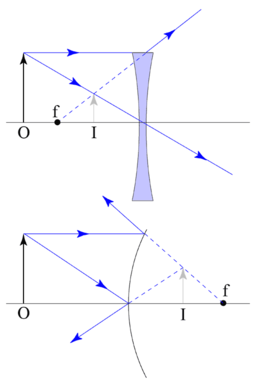
Virtual image
Encyclopedia

Optics
Optics is the branch of physics which involves the behavior and properties of light, including its interactions with matter and the construction of instruments that use or detect it. Optics usually describes the behavior of visible, ultraviolet, and infrared light...
, a virtual image is an image in which the outgoing rays
Ray (optics)
In optics, a ray is an idealized narrow beam of light. Rays are used to model the propagation of light through an optical system, by dividing the real light field up into discrete rays that can be computationally propagated through the system by the techniques of ray tracing. This allows even very...
from a point on the object always diverge. It will appear to converge in or behind the optical device (i.e., a mirror). A simple example is a flat mirror
Plane mirror
A plane mirror is a mirror with a plane reflective surface.For light rays striking a plane mirror, the angle of reflection equals the angle of incidence...
where the image of oneself is perceived at twice the distance from oneself to the mirror. That is, if one is half a meter in front of the mirror, one's image will appear to be at a distance of 1 meter away (or half a meter inside or behind the mirror). Because the rays never really converge, one cannot project a virtual image.
By contrast, a real image
Real image
In optics, a real image is a representation of an object in which the perceived location is actually a point of convergence of the rays of light that make up the image. If a screen is placed in the plane of a real image the image will generally become visible on the screen...
is an image in which the outgoing rays from a point on the object pass through a single point. It is easiest to observe real images when projected on an opaque screen. A screen is not necessary for the image to form.
- When we look through a diverging lens (at least one concave surface) or look into a convex mirror, what we see is a virtual image. However, if we observe a focused image on a screen inside or behind a converging lens (at least one convex side) or in front of a concave mirror what we see on the screen is a real imageReal imageIn optics, a real image is a representation of an object in which the perceived location is actually a point of convergence of the rays of light that make up the image. If a screen is placed in the plane of a real image the image will generally become visible on the screen...
because the image really is at the screen's location. If we position ourselves so that the screen is directly between ourselves and the optical device (mirror, lens, etc.), we can remove the screen and still observe the image. A converging lens and concave mirror are also capable of producing virtual images if the object is within the focal length.
- For example, a planePlane (mathematics)In mathematics, a plane is a flat, two-dimensional surface. A plane is the two dimensional analogue of a point , a line and a space...
or convex mirrorMirrorA mirror is an object that reflects light or sound in a way that preserves much of its original quality prior to its contact with the mirror. Some mirrors also filter out some wavelengths, while preserving other wavelengths in the reflection...
forms a virtual image positioned behind the mirror. Although rays of light seem to come from behind the mirror, light from the source spreads and exists only in front of the mirror. In drawings of optical systems, virtual rays are conventionally represented by dotted lines. Optical rays represent paths on which light actually travels. A virtual ray (the dotted lines) represent perceived paths as seen by an observer looking into the optical device. The light rays do not travel on these dotted paths. A point on the image is located where the virtual rays intersect.

